| The challenge:
To build a tandem kayak and
Greenland paddles and race in the 2007
Watertribe Everglades Challenge.
The Challenge is a 320 mile adventure travel race
from Tampa to Key Largo, Florida for small human powered
boats. Paddlers go through three extreme environments;
open water Gulf of Mexico paddling and sailing, Everglades
inland waters and swamp paddling, and Florida Bay
marsh and shallow bay paddling. The racers have to
be self contained and have up to 8 days to complete
the race. There are four racing Classes; Class 1 -
Expedition Kayaks and Canoes; Class 2 - Racing Kayaks
and Canoes with downwind sails; Class 3 - Sailing
Kayaks and Canoes; Class 4 - Small Sailboats. Last
year, 2005, the fastest tandem expedition kayak with
downwind sails was paddled by SaltyFrog and RiverSlayer
aka Marty Sullivan and Rod Price in 3 Days, 6 Hours,
30 Min
Over the past several years, my friend, Dan Lockwood
and I have completed the Everglades Challenge. In
2004 and 2006 we used his Sea Pearl, a 21 foot cat
ketch that launches from the beach (a requirement
of this race) and rows easily. This upcoming year
we wished to paddle a boat that we built with our
hands in keeping with the concept of self sufficiency.
 |
Dan and I last
year sailing across Florida Bay, near the end
of the race.
(click images
to enlarge) |
The race goes for a week of round the clock sailing
and padding, so we needed a boat that was comfortable,
stable, yet fast. David has built two Pygmy boats
in the past, a Golden Eye Hi and a Coho and Dan Lockwood
built a Golden Eye standard. We liked their designs
and all three of our boats are light, fast, track
well and handle ocean waves beautifully. David paddles
regularly on the Ohio River and its tributaries. Dan
takes his Golden Eye paddling in the surf and tidal
estuaries around his home on Tybee Island. We have
paddled Klepper Arieius II double kayaks for the past
30 years taking long adventures in the Americas. We
have significant experience in a tandem boat.
For the 2007 watertribe race, we decided on the Pygmy
Osprey Triple. The Osprey triple is 20 feet long,
30 inches wide and weighs 61 pounds fully decked out.
Both the Osprey double and the triple use the exact
same hull and deck; to make the triple Pygmy pushes
the bow cockpit forward and the stern to the rear,
enough to fit a third full size cockpit in the center.
We think that the Triple will have several advantages
over the Double Osprey. First, the ability to store
equipment in the center section and second when the
bow and stern paddlers paddle at the same time, they
do not have to be in synch – with paddling long
distances over 16 hour stretches, this is important.
But mainly at home, the triple is a great way to get
the family to be able to take advantage of the boat.
A big disadvantage is the bow paddling compartment
is a little tight and the bow and stern storage areas
are smaller. We think that the Pygmy Osprey triple
will serve as a good expedition boat as well as an
ideal family boat. It is light, fast, stable and tracks
well in addition the boat is beautiful.
During the spring of 2006, we sought and received
sponsorship for our participation in the Watertribe
Race from Pygmy
Kayaks who provided us with an Osprey
Triple. The kit arrived on May 28 and five weeks later
Dan and I paddled it in an ACA accredited race on
July 7, 2006 in Cincinnati at the Ohio River Paddlefest.
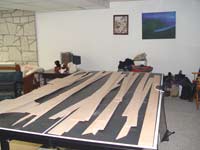 |
I began by unpacking
and sorting the wood and stowing all of the
materials and tools. I would encourage others
to not neglect the preparation time. |
In the weeks leading up to my boat building frenzy,
I did invest some time on preparing my boat building
bench. My two other pygmies, Golden Eye – 16
foot, and Coho – 17-6, were just the right size
for my workroom. For the Osprey Triple, one needs
an absolutely flat and stable work area, 21 feet long
and 24 inches wide. By making it 24 inches wide the
work bench could be made from a 4’ by 8’
¾” sheet of plywood. The Osprey Triple
is 30 inches wide in the center, which means there
is not a lot of space.
In preparing the work room, I set up a a dedicated
set of book shelves for the material and tools, a
separate table (an old ping pong table), an epoxy
station, sanding area and a storage area for boat
parts were set up. The work space did not have a dust
collection system, so sanding was done in outdoors
on two saw horses.
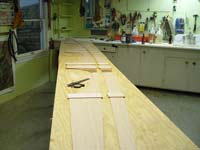 |
Pay special
attention to laying out the wood, it is crucial
to have the sections of the wood butt up perfectly
and be absolutely true.
|
Part of the preparation is reading the Pygmy manual
from beginning to end, twice. This will provide the
builder with a good idea of the flow of boat building.
The first piece of advice to new boat builders, is
to thoroughly understand the steps that you are about
to undertake. If you don’t understand something,
stop re-read, and re-read, and then call the Pygmy
staff, which is ever patient and helpful. I found
The West
Coast Paddler web site helpful. The site
details the boat building process in narrative and
photographs.
Laying the keel in a straight line is crucial. While
building my first two pygmy kayaks, I had difficulty
with the overall alignment of the boat. This time
around, I bought a laser line level, a portable battery
power device that allowed me to send a red laser line
down the keel to make sure it was absolutely straight.
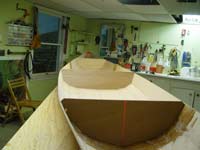 |
I bought a laser
line level (a portable battery powered device)
that allowed me to send a red laser line down
the keel. |
I did this during every step, until the epoxy was
hardened. Having the Keel and the deck aligned properly
saves all sorts of work down the road and ensures
a boat that tracks properly.
My 11-year old child, Dakota, was a faithful assistant.
After my third boat, I do have some advice on building
the boats with kids. There are certain steps that
are better to involve them with than others. Four
of her favorites were stitching the panels together
with the six inch wire, sanding the boat (just watch
closely if you allow them to use the orbital sander),
painting on fill coats of epoxy and clamping on the
cockpit rims.
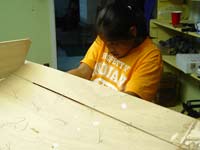 |
Dakota threading
wires between the second and third panels of
the hull.
|
Dakota mixing the
epoxy.
|
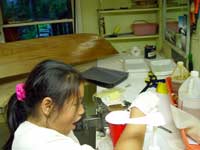
|
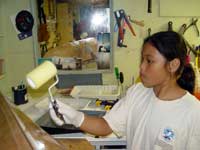 |
Dakota putting
on a fill coat once the fiberglass was laid
down. |
Dakota sanding
|
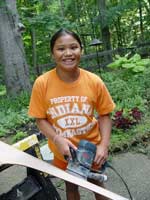
|
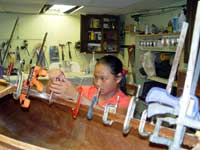 |
Dakota clamping
|
Dakota drilling
|
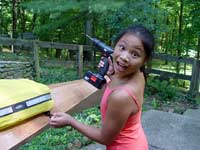
|
The Osprey Triple took 72 hours of construction time
over five weeks. It was structurally finished but
one has to wait 4 to 5 weeks for the epoxy to fully
cure, before applying the spar varnish. This allowed
an opportunity for two official boat launch parties.
Our first party was at The
Paddlefest in Cincinnati, Ohio, July
7 and 8, 2006, our region’s largest canoe and
kayak festival. There were over 2,000 boats paddling
in the race and paddle events. We set up a booth at
the educational programs, wooden boat show and kayak
festival the day before the race. During the festival,
our goal was to finish mounting the seats, foot braces
and deck rigging as an interactive display. Many pygmy
boat owners stopped by and talked about their boats,
as did thousands of others who were just interested.
We finished the boat late Friday night, got our race
numbers and went to sleep in a noisy energized campground.
 |
As we finished
the boat, thousands of young children and adults
came by to talk to with us. |
| The Osprey Triple
in front of voyageur canoes at the Ohio River
Paddlefest. |
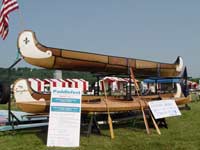
|
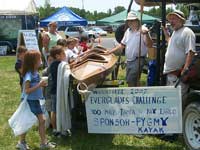 |
Young Children
visiting Paddlefest and the building of the
Osprey Triple. |
| Over 5,000 kids
and adults from the Ohio River Valley visited
the booth during the day of final construction.
|
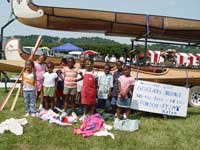
|
Saturday morning, we launched of the boat on her
maiden voyage by entering it into a nine-mile canoe
and kayak race sanctioned by the United States Canoe
Association. We entered as a tandem Kayak; we came
in first in our division with a time of one hour,
nineteen minutes and fifty five seconds. We had the
second best time overall, not bad for a 54 and a 62
year old paddler.
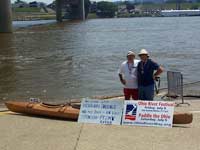 |
Dan Lockwood
and David Wicks standing by their Osprey Triple
after winning their division and coming in second
overall in the Ohio River Paddle Fest 2006 |
To finish off the dedication and to further get a
feel of the boat, we paddled home from Cincinnati
to Louisville. We ended up in Louisville 2 ¼
days later, a distance of 123 miles in a bit less
that 30 hours of paddling time, an average of 4.1
miles an hour. (We could have kept better track of
this time, and we took some long breaks in the towns
along the way) The Osprey Triple preformed admirably,
but these were very mild conditions, nothing like
we encountered in our previous WaterTribe races. It
was comfortable, fast and lightweight, just as we
thought.
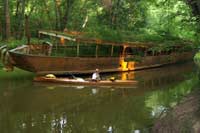 |
Our first night
downriver was in a small tributary of the Ohio
River with a derelict party boat |
| We stopped on our
trip for breakfast and lunch at small towns along
the Ohio. |

|
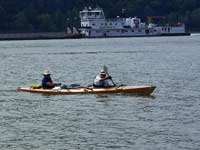 |
Barges were
ever present. The Ohio is one of the busiest
rivers for commercial traffic in the world.
|
We got the boat home and put it back in the workshop
for the final prep work - sanding the boat thoroughly,
and putting on three layers of marine spar varnish.
A month later while hosting a national conference
for Paddle Safe, Paddle Smart, a new American Canoe
Association education program funded by the U.S. Coast
Guard, Pam Dillon, ACA executive director, Tom Evaul
President of that American Association for Physical
Fitness, Recreation and Dance (APAR), Gail Kulp, Education
Director for the for the National Association of State
Boating Law Administrators (NASBLA) along with Gordon
Black and Becky Molina, two ACA instructor trainers
and nationally ranked paddlers participated in the
formal dedication of the boat. I am calling our boat
“The DW” named after my daughter Dakota
Wicks.
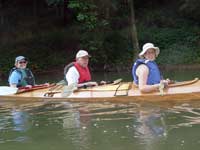 |
Pam Dillon,
executive director of the ACA, Tom Evaul, APAR
President and Gail Krup Education Director of
NASBLA dedicating the Osprey Triple
|
| Three Pygmy Kayaks,
The Golden Hi High, the Co-Ho and the Osprey Triple.
|
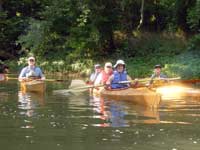
|
We regularly go out and paddle and play in the boat.
We often take short trips on the Ohio River and practiced
wet exits and tested the stability of the boat.
Class one of the WaterTribe race allows for downwind
sails. They limit the size of the sail to one square
meter per paddle. Pacific
Action Sails agreed to sponsor us as
well and sent two, one square meter sails for the
boat. The sails are downwind sails only to be used
when the wind is 120 degrees from the stern. The bow
sail fit well on the bow but we had to make adaptations
to fit the second sail over the center cockpit.
In October of 2006 Dan Lockwood and I met at T.H.
Stone Memorial St. Joseph Peninsula State Park in
Florida’s Pan Handle for three days of sea trials
in the Gulf of Mexico. We solved the problem of mounting
the center sail by mounting a “Johnny Bar”
and then strapping the Pacific Action Sail to it.
On our first sail we went eastward 25 miles to St.
Vincent National Wildlife Refuge with 10 knot westerly
winds with a two foot rolling swells, wave height.
The Osprey Triple averaged 5.5 miles per hour over
the 25 course. On the paddle back we had a 10 knot
head wind which made the paddle a long one. We arrived
at the park around 4:30 am, with an average speed
of 2.7 mph.
We have decided against bulkheads and hatch covers
to save weight, the bow and stern sections were small
and we wanted to experiment with sleeping in the boat.
The second day we swamped the boat and practiced self
recovery. We determined that we needed to added additional
floatation. Then we paddled and sailed due south 10
miles into the gulf and had a beautiful night paddle
in return. Our third day, we packed up the boat and
paddled to the primitive camping of the state park.
Dan slept in the boat, while I set up a one person
tent. We capped off the adventure with a 10 mile sail
with 15 knot westerly winds. Under both sails and
paddling we averaged 6.0 mph and had a top speed of
7.2.
The second big preparation trip was a Christmas
vacation to the Everglades for my family. We drove
to Everglades City with three pygmy’s; The Osprey
Triple, The Golden Eye Hi and a Coho. Our first five
nights we stayed in a nice hotel called the Captains
Table. It was right on the water and
about a mile from the Everglades
National Park visitor Center.
I got up every morning by 4 and had wonderful pre
dawn paddles. I was back in time to have breakfast
with the family. Then we went for a longer day paddle.
We explored Turners Creek, Chokoloskee Pass, Rabbit
Key Pass and Sunday Bay. On the final day at Everglades
City my son, Graeme, and I paddled and sailed the
Osprey Triple out Indian Key Pass and then Northwest
to Marco Island. We had 10 to 15 knot southeast winds
with two foot chop, which made the 30-mile paddle
go by very quickly.
Since the October trip, I made several improvements
that worked out well. I made a wooded cockpit cover
for the center cockpit. In essence the wooden cockpit
cover turned the triple into a double. It allowed
me to mount the Garmin 76 csx unit easily and it provided
a secure mounting spot for the second pacific action
sail. I also fiber glassed eight d-rings into the
center cockpit area that are used to anchor flotation
and any water proof bags. I installed a seaward rudder,
but did not use it. After 35 years of paddling without
rudders, I was not convinced of the need, also I felt
that it might cramp my legs constantly using the rudder
peddles. In retrospect, I wish I had tried it out,
with both Pacific Action Sails up in a 15 knot wind,
it took constant paddling or using the paddle as a
rudder to keep us on course. Another big change was
that I bought a Epic Mid Wing Hybrid paddle. What
a difference a good light weight paddle makes.
At Marco Island, we landed at the beach and stayed
at the Marriott. Not a typical kayakers haunt, but
it was pleasant. Over the next couple of days, the
family and I explored Cape Romano and western edges
of the Thousand Islands. All in all, the Christmas
2006 family trip made me much more comfortable with
the osprey triple and in knowing second check point
for the Everglades Challenge in all types of weather,
tides and times of day.
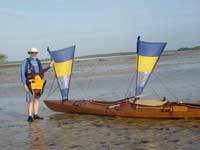 |
The author at
low tide at one of Thousand Islands in southern
Florida. |
Close up of the
wooden cockpit cover. It is anchored with stainless
steel bolts and wing nuts.
|
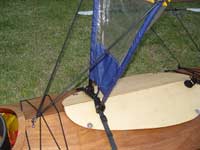
|
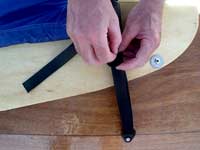 |
The Pacific
Action Sail straps on to the deck. Difficult
to do underway, but the sail can be stowed on
the deck and then raised and lowered using the
elastic stays.
|
| The elastic stay
mounts to the deck. |
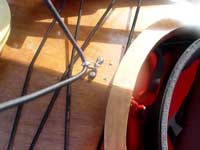
|
While we were in the Everglades, my daughter Dakota
Wicks decided to do her 6th grade science fair project.
 |
 |
 |
 |
 |
Epic
Wing Paddle
|
White
Water
|
Greenland style
|
Canoe Paddle
|
Sea
Tour
|

This is just one of the graphs she created,
after 5 of us paddled several times with each paddle,
over a 100 meter course, Dakota analyzed the data
by weight, blade size, length. She concluded that
the age or physical fitness of the paddle did not
matter. All five participants had consistent results
for all the paddles.
- Fastest – Wing Paddle
- Second – White Water Paddle
- Third – Wooden Inuit
- Fourth – Sea Touring Kayak
Paddle
- Fifth or the slowest –
Canoe
She also said that for a 100 meter sprint the length,
weight nor the size of the blade of the paddle made
a difference in the average or maximum speed. The
design of the paddle was the only difference. The
Wing paddle with its modern airplane-shaped blade
caught the water and made the boat go faster. The
White water paddle that was second fastest has a big
blade and is very strong and heavy.
On the WaterTribe race, I plan on bringing the Epic
Mid Wing, my home made Inuit or Greenland style paddle
and my home made canoe paddle. Even though they are
heavier, I find changing paddle types rejuvenates
me and I can continue paddling on, and on and on.
Between now and race time, March 3 to 11, I plan
on paddling 40 to 60 miles a week and concentrate
on stretching and strength exercises. We are entering
are practice race times in the Marek
Uliasz’s virtual race program.
It is nice to see our time on the web.
We also have to plan our route in detail and organize
our gear and food lists. One big advantage this year
is that we have our shuttle worked out. In previous
years for the Watertribe race, I have done the shuttle.
For the last race in 2006, I drove the car and trailer
to Key Largo and caught Greyhound back to Fort Desoto,
arriving at 3:30 am, 4 hours before the race. This
year, my friend Gus Rice has agreed to accompany us
and drive the shuttle. We plan on being at Fort Desoto
two full days in advance, not only to ensure that
we are well rested, but we pack the boat, get our
food, etc. etc. There is no guessing how we will do
in the race because a lot depends on the wind speed
and direction, but our preparations have been as thorough
as we can make them.
Many thanks to the folks at Pygmy Kayaks and Pacific
Action Sails for their sponsorship.
To learn more about the WaterTribe race and the adventure
racers who participate in it, visit:
https://www.watertribe.com/
To learn more about pygmy boats visit:
https://www.pygmyboats.com/
To learn more about pacific actions sails visit:
https://www.pacificaction.com/
If you want to read more about our adventures check
back with Duckworks.

More Watertribe Stuff
|